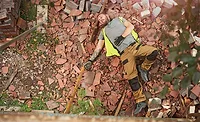Pro-active planning and training made this rapid rescue from the TD Bank Sports Center a success
A Roof Rescue Revisited
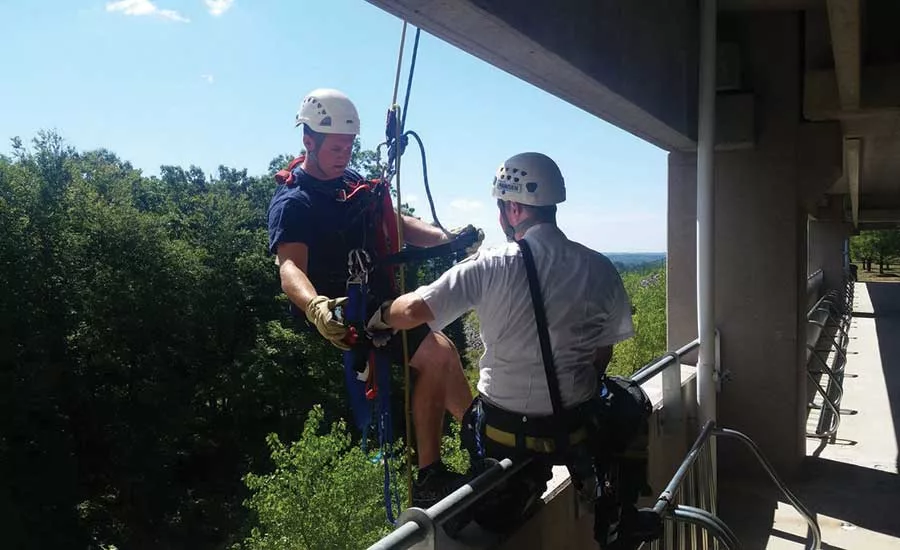
Members of the Hamden, Conn. Fire Department (HFD). Photos courtesy of the HFD.

Members of the Hamden, Conn. Fire Department (HFD). Photos courtesy of the HFD.

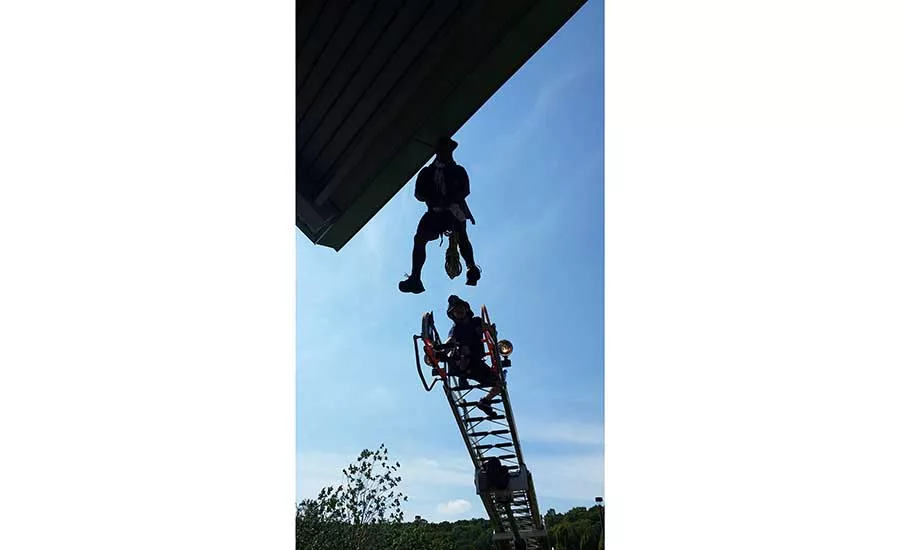
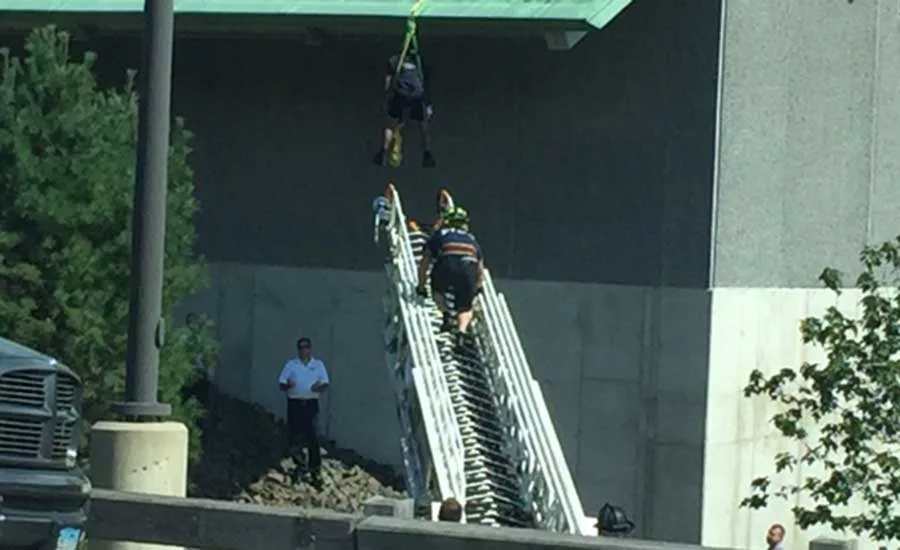
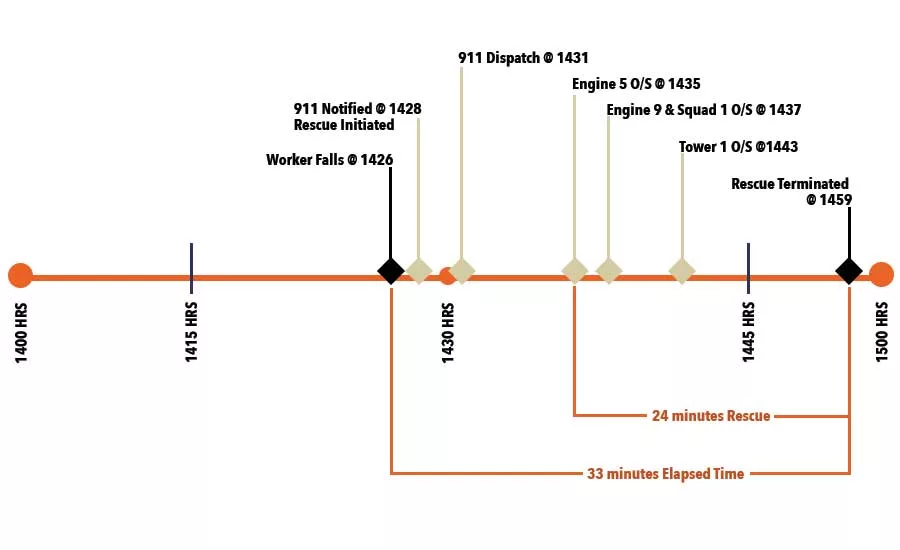
Whenever I think about roof rescues, the words “simple,” “efficient” and “rapid” hardly ever come to mind. In general, there are too many variables on most roofs for an elevated rescue operation to ever be considered “easy.” You can imagine how my interest was piqued when I ran across a recent online news article of a roof rescue performed in less than a half hour by the Hamden, Conn. Fire Department (HFD). While cleaning the single- ply EPDM synthetic rubber membrane of a barrell roof with his partner, a 57-year-old employee of the CSC Hood and Duct Services, of Windsor, Conn., slipped on his lifeline and fell off the 135,000 square-foot roof of the TD Bank Sports Center at Quinnipiac University’s York Hill Campus. It was a calm, partly sunny summer day with temperatures in the low eighties. After incurring an arrested fall in a personal fall arrest system (PFAS), the worker hung suspended from his lifeline about a body-length below the eave of the roof — about 35 feet above a trap-stone embankment.
Due to remote component positioning, he was obviously incapable of self-rescue by either ascent or descent. In previous articles, I’ve spoken about the late Harvey Grant, who’s often lauded, (along with James Gargan and Robert Murray, Jr.) as the “father” of modern emergency rescue techniques well ahead of his time. For the purpose of emergency response training and rescue evaluation, Grant broke down emergency response events into twelve sequential and timed phases, divided into three groups of four procedural steps each.
According to OSHA’s 29 CFR, Part 1926.500, every employer’s “duty” to provide fall protection to his/her employees includes the duty to rescue them promptly should an arrested fall occur. Likewise, any OSHA-compliant, corporate fall protection plan should include a method for developing a site-specific emergency action plan to accommodate every worker with a potential to fall and become suspended above a lower level by his/her PFAS. A rescue plan which is worthy of its implementation costs should also be capable of being changed at any time, without significantly altering primary goals or timeline. Although considered simply recommended guidelines for first responders, Grant’s 12-Phases of Rescue would be the logical starting point for most employers, as details can be inadvertently missed or intentionally ignored in the “fog of war” pervasive at most accident scenes. The predominate feature of Group One is pre-emergency preparations, including, but not exclusive to:
- Tool and equipment selection
- Personnel designations
- Incident command system
- Personnel training, drills and evaluations
It’s evident from my investigation that both the employer, CSC Hood & Duct Services, founded in 1982, as well as the HFD Firefighters had both prepared for such an emergency. Bill Benito, president of CSC Hood and Duct Services, and his son, Phil, company vice president, proposed, bid and won many cleaning projects over the years at Quinnipiac University. Those included building, exhaust hood, air handling, and cooling tower cleaning. In this particular case, the university asked them to develop the scope of work for the bid on cleaning the stadium roof for the purpose of recoating and extending its functional lifespan. As part of the scope, Bill realized that this large roof had a progressively pitched arch, which was nominally flat at the ridge and close to 10:12 at the eave. Built on a tiered slope, the vertical eave elevations of the arena ranged from 20 to more than 120 feet. With significant OSHA training and fall protection experience, Phil understood this project would require a custom-designed and built PFAS that would allow his workers both maximum range of motion as well as feasible access to hand clean all 1,300 squares of rubber membrane with truck brushes and liquid cleaning solutions. His scope of work included building a customized FP system of two-man-rated primary and secondary, horizontal and vertical lifelines of about 6,300 lbs. static tensile strength across the roof, all anchored to the building’s existing structural steel ice deflectors below. He also installed multiple and opposite tieback lines at both ends of the ridge to counteract lateral forces if a worker should fall off of the rake edges. Every lifeline was tied into either a primary or secondary anchor four times for redundancy. In order to eliminate damage to the single-ply membrane, he selected 3-foot SA roofer lanyards which, when used properly, would raise the lanyard hardware off of the deck. He trained his crew to reposition their rope-grab devices during roof ascent and descent, emphasizing that they keep their lifeline slack to a minimum in an effort to reduce roof slide distances should they fall. He also trained his personnel to inspect every component of this “spiderweb” system prior to each shift, as well as the necessary rope management skills to minimize system entanglement and slip/trip hazards. From his description of this system, I’d classify his custom-built PFAS as close to “bombproof” as possible, while still feasibly permitting the completion of their work.
With 35 years in the burgeoning duct-cleaning business, Bill sits on the National Air Duct Cleaners Association’s (NADCA) education committee. He eventually became a certified air system cleaning specialist and NADCA president. Over three decades, CSC Hood and Duct Services grew to 11 service vehicles and 25 field employees. The company worked for many of the nation’s largest firms and met or exceeded most stringent safety and health program requirements. This two-man roof cleaning crew also received initial and regularly upgraded fall protection training for this job designed from Phil, CSC’s competent person for fall protection. Instruction included the proper procedure to install and use the customized PFAS on this EPDM membrane roof, as well as a pre-use fit-test procedure for their full-body harness and a comprehensive “out-of-service” policy. He emphasized the need to implement the buddy system on the roof and how to maintain situational awareness on the progressive-pitched roof.
He also instructed them on how to properly don, doff and pre-use fit-test the harnesses in order to reduce the potential for harness-induced pathology during an arrested fall. On the day of the accident, the worker was momentarily distracted while making his way up the steeper roof pitch toward the ridge. Rather than repositioning his rope grab every few feet, he created as much as 20 feet of slack in his lifeline. He accidentally stepped on the loose tail of his lifeline, lost his balance and fell face-first onto the deck.
At that steep pitch he slid downslope on his stomach, fell off the eave and spun 180 degrees into a heads-up suspension just below the eave. Witnesses later said he appeared as comfortable as possible during his post-fall suspension and was physically capable of exercising the “muscle pump” in both legs while awaiting rescue. He was even heard making Superman jokes with the first responders operating the fire department’s ladder truck.
Capt. John Grasso, the HFD’s training and EMS director, discussed the rescue operation’s timeline in detail. He mentioned that his department had coincidentally trained high-angle rope rescue drills at the parking garage facility at the same campus earlier that year. The firefighters are trained in emergency medical services as well, with ninety two paramedics/EMTs on call. After the initial 9-1-1 call, 20 rescue personnel responded on four different vehicles from three stations all located within five to 10 miles from the scene.
Whenever proper rescue preparation is ignored, I often observe extended notification (employer) and response (rescue service) times. Any delays experienced at the front end of an emergency have a tendency to “snowball” as the operation evolves, dragging out the elapsed time to hours rather than minutes. While many emergency responders might agree that the luck-of-the-draw plays an integral part in any rescue, the old adage, “I’d rather be lucky than smart” has no real place in a professional rescue operation. Without a thorough table-top exercise to determine which potential, probable, or possible hazards could be encountered during an aerial rescue, and then conducting site-specific drills with performance evaluations, there would be no means to definitively measure the degree of success of any rescue response. In Hamden, firefighters train for high-angle rescues regularly.
While every one of Grant’s 12-steps may be considered critical after preparation, the next most important rescue step, in my opinion, is response. Response begins once emergency services have been notified of the particulars of an emergency. Once the notification call is made, first responders hit the road and the Golden Hour begins.
As with the rest of life’s challenges, it’s all relative. For instance, a response route with several major highway intersections without emergency-vehicle-preempted signals may pose more of a delay than would be expected. Variables such as commuter rush hour and severe weather conditions may also create a drag on response times. Depending on the scenario, valuable time elapsed from either: The duration of the fall; the time it took the victim to declare an emergency requiring technical rescue; or the time it took to complete an emergency notification call.
Fortunately in this case, it appears that very little time was wasted in doubt or hesitation by company employees on-site. Once the first responders arrived, the arrested fall victim and his employer would have completed their only feasible contribution to the rescue effort. When it comes to rapid response, only 30 seconds saved by the employer’s emergency response preparation may account for a pint less of blood loss, or 25 more breaths taken. Beyond that point, it’s up to the technical rescue team to take command of the incident scene.
Pre-Fall Acts and Conditions
The U.S. Bureau of Labor Statistics started analyzing the direct and indirect causes of all OSHA-reported accidents in1972 and found that roughly 60 percent of the direct causes of all occupational injuries, illnesses and deaths are due to worker acts, with only 40 percent caused by workplace conditions. The CSC Hood and Duct Co. worker in this case had 14 years of accident-free employment and accidentally stepped on his lifeline lying on the barrel-sloped roof. In less than 10 seconds, he lost his balance, fell and slid downslope before having an arrested fall.
Whenever implementing a PFAS on any roof, the competent roofer must maintain situational awareness of his gear and practice basic rope-management skills while working. As the first-man-up, he must arrange the components of his PFAS in an organized and feasible layout according to his tasks while maintaining 100 percent fall protection. Even with multiple years of experience without an OSHA-recordable accident, it only takes a few seconds of distraction while working with ropes to slip, trip or fall. It appears from the scene photographs that this worker had securely coiled his undeployed lifeline and lowered it off of the roof edge, creating a tension anchor that would facilitate manually raising and lowering his rope-grab device as he worked up and down the roof slope.
We can see from the close-up of the victim, his harness shoulder straps and dorsal D-ring elongated from terminal impact, leaving his lanyard and rope grab device unreachable up on the roof deck overhead. Unlike a truly vertical 6-foot freefall, his terminal impact force in this case would have been considerably less than the maximum-rated 1,800 lbs-per-foot. As a result, common with most roof slide/falls, his energy-absorbing lanyard may not have fully deployed, elongating to less than the additional 3 ½ feet intended.
Post-Fall Acts and Conditions
Once his fall-arrest terminated with his head located just below the eave, the victim was immediately suspended in his harness. Orthostatis is the state of being vertically restrained such that an upright orthopedic posture is maintained. The ensuing orthostatic hypotension is the loss of blood pressure (relative to the supine position) within the first three minutes. In this case, as self- and assisted-rescue options were not available, all the post-arrested-fall (PAF) victim could do at this point was wait for a technical rescue response. His cardiovascular system would soon start to react to his orthostatic posture, as gravity would begin pooling venal blood in the vessels of both legs. The veins in both legs can distend creating 16 times their normal fluid volume. All five liters of the body’s total blood volume may accumulate in both legs. An extended period of suspension (greater than 15 minutes) would likely produce a faint cycle where the brain signals the body to collapse to a prone position in order to equilibrate blood pressure and return oxygenated blood to the heart, lungs, and brain. Despite an initial fainting episode, the PAF system prohibits the body from becoming recumbent, thus causing the brain to produce more fainting episodes. At terminal impact force, the harness leg straps may have elongated and then retracted, becoming bilateral tourniquets on the femoral veins in the groin. This further contributes to loss of blood flow back to the core organs. Eventually, if adequate blood flow is not restored, systemic acidosis develops from the toxins accumulating in the blood, primary organs begin to fail, and the victim may ultimately succumb to cerebral hypoxia.
Fortunately, workers trained in orthostatic suspension have the opportunity to manipulate the “muscle pump” in their legs to overcome some of these deleterious symptoms of suspension trauma. That’s the development of cardiovascular symptoms during prolonged upright posture which may be immediately relieved by recumbency. Anatomically, the femoral veins run between muscles and bones in both legs. By repeatedly flexing his leg muscles, the PAF victim may effectively muscle-pump blood flow past numerous bicuspid valves back to the heart, lungs and brain. If, due to terminal impact, the leg straps have not cinched and collapsed the sub-cutaneous femoral veins in the groin, continuous muscle pumping may easily extend the period of time the fall victim may survive post-fall orthostatic suspension. However, if the femoral veins are collapsed, devices such as Prussik loops, trauma relief straps or CMC/ROCO’s Freedom Harness™ may provide sufficient body-load relief and webbing slack to permit blood flow to return to the core organs. Caution must always be exercised such that the harness buckles are not released accidentally during this maneuver.
Prior to this incident, the employee for CSC and a co-worker were hand-cleaning the arena’s barrel roof rubber membrane. A Quinnipiac student having a meal by a window at the student center overlooking the TD Bank Sports Center witnessed the worker’s fall from the roof. He immediately used his cell phone to call 9-1-1. Dispatchers processed the call, sounded the alarm quickly and the rescue team from Hamden Fire Station 9 (about 5 miles away) responded at 2:30 p.m. They were soon followed by firefighters from other stations between five and 10 miles away. They were on scene in less than six minutes. The first squad quickly directed crews to the victim suspended 35 feet over the trap-stone embankment at the northwest corner of the complex. Upon arrival, the incident commander staged a tower truck to the west of the building below the victim. With outriggers deployed, they extended the ladder about 35 feet over the rear for a low-angle pickoff of the victim. Within 33 minutes of the victim’s initial fall, he was medically evaluated and cleared fit for duty. The rescue operation was terminated at 2:59, within 24 minutes of the first squad’s arrival. The CSC crew replaced the affected equipment and returned to work for the remainder of their shift. There were nine more recorded minor fall-in-place incidents without injuries prior to completion. These were due primarily to the steep and slippery conditions of the work, but with lifeline slack now properly managed, no one slid more than two feet downslope. According to the project manager, this roof cleaning job ultimately finished within budget and one day ahead of schedule.
In Conclusion
In total, 26 emergency personnel responded to this incident, including ambulance, fire fighters/EMTs, police officers and university officials. With only one incident commander from the HFD, the confluence of pre- and post-accident events combined to optimize Harvey Grant’s 12-Steps of Rescue. The final outcome of this high-angle technical rescue inevitably proved successful, meaning — the landmarks of the rescue operation are safely achieved; all in a timely manner; and according to a practiced plan.
Upon critical review, every rescue operation can be improved by replacing or modifying any one of its four components: personnel, material, equipment or procedure. The prime directive for all rescue operations is, “The rescuer’s safety shall always come before the victim’s rescue” in order to prevent adding to the victim list. In this case, the firefighter/EMT on the ladder performing the victim’s pickoff was 100 percent tied off with an NFPA-approved internal-harness pants and lanyard. A pickoff maneuver is based on gravity, force vectors and the transfer of load from the roof lifeline to the ladder while maintaining 100 percent fall protection for rescuer and victim. Whenever I ponder a “what-if” roof-rescue scenario in training class, I resist the temptation to confound acts and complicate conditions on the jobsite, much as real-life presents. It’s often my trainees who suggest more complex scenarios drawn from their real-life experiences.
The truth is, it doesn’t take much to derail an unplanned rescue operation: A sudden cloudburst, an adjacent “gawker” accident, a ladder three feet too short or the inevitable interference from those untrained and ill-equipped individuals who insist on “being of assistance.” When your first rescue is your first drill, it’s not uncommon that someone may end up in the emergency room or the morgue. But when a rescue is executed as planned and repeatedly drilled in evolutions, it becomes increasingly harder to deflect these short and long-term goals. In this case, firefighters successfully performed Grant’s 12 steps within a 24-minute rescue window. This is simply the most successful roof rescue op this safety consultant will probably ever evaluate. Although, to a man, they told me they were just doing their job as instructed, my congratulations go out to everyone on their thorough PFAS preparations and safe rescue practices.
Looking for a reprint of this article?
From high-res PDFs to custom plaques, order your copy today!



